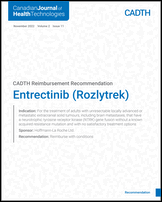|
Initiation
|
| 1. Patients should have all of the following: 1.1. unresectable locally advanced or metastatic extracranial solid tumours, including patients with brain metastases 1.2. NTRK gene fusion 1.3. without a known acquired resistance mutation 1.4. good performance status. | The approved indication for entrectinib is limited to adults with unresectable locally advanced or metastatic extracranial solid tumours who have no satisfactory treatment options. Enrolment in the pivotal studies for entrectinib was limited to patients with good performance status (ECOG performance status of ≤ 2). | pERC noted that NTRK fusion testing is not used universally across all public drug programs and cancer agencies in Canada. Because testing methods for detecting NTRK fusion are evolving, upon implementation of the reimbursement recommendation, the jurisdictions may need to consider a common approach to define their NTRK fusion–testing strategies to ensure equitable patient access and cost-effectiveness (e.g., through health technology assessments of companion diagnostic testing). |
| 2. Reimbursement should be limited to adults (≥ 18 years of age). | Entrectinib is not approved in Canada for use in pediatric patients. | ― |
| 3. All available standard treatments for that tumour site should have been previously used and exhausted. | The Health Canada–approved indication for entrectinib is limited to patients who have no satisfactory treatment options. | ― |
| 4. Reimbursement with entrectinib should not be initiated in patients who have primary CNS tumours but may be provided for those with controlled or asymptomatic CNS metastases. | The Health Canada–approved indication for entrectinib excludes patients with primary CNS tumours but includes patients with extracranial solid tumours who have CNS metastases. | ― |
| 5. Reimbursement with entrectinib should not be initiated in patients who have received prior treatment with an NTRK inhibitor. | Patients with prior exposure to an NTRK inhibitor were not included in the pivotal studies for entrectinib. There is insufficient evidence to evaluate the efficacy of sequential usage of entrectinib or larotrectinib after disease progression on 1 of the 2 drugs. | ― |
|
Renewal
|
| 6. Assessment for renewal of entrectinib should be based on radiographic evaluation (CT and/or MRI): 6.1. every 3 to 4 months for the first year after treatment initiation 6.2. longer interval follow-up may be continued thereafter based on clinical judgment. | This interval is used widely for assessment and radiographic monitoring in oncology. For patients with a sustained response to entrectinib, increasing the imaging interval would be acceptable based on clinical judgment to avoid exposure to radiation. | ― |
|
Discontinuation
|
| 7. Reimbursement should be discontinued upon the occurrence of any of the following: 7.1. radiographic disease progression 7.2. unacceptable toxicity. | There is no evidence that re-treatment with entrectinib is effective for patients whose disease has progressed after treatment. | ― |
|
Prescribing
|
| 8. Entrectinib should only be prescribed by a clinician experienced in diagnosing and treating patients with NTRK gene fusions. | This condition is required to ensure that entrectinib is used in an appropriate care setting. | ― |
| 9. Entrectinib should be administered as monotherapy and should not be given in combination with other systemic anticancer therapies. | The trial data were used to evaluate the efficacy and safety of entrectinib as monotherapy. | ― |
|
Pricing
|
| 10. A reduction in price. | If testing is required to determine eligibility based on NTRK fusion status, then there is no price at which entrectinib could be considered cost-effective at a $50,000 per QALY threshold. This assumes next-generation sequencing testing must be conducted to determine eligibility for entrectinib, and this test would not have been conducted otherwise. If the cost of testing to determine eligibility based on NTRK fusion status is excluded from the total treatment cost, then entrectinib would require a price reduction of at least 82% to potentially be considered cost-effective at a $50,000 per QALY threshold. Higher price reductions may be required depending on what therapies are displaced and whether subsequent treatment costs are incurred after treatment with entrectinib. No evidence was presented that suggests entrectinib produces better health outcomes relative to other NTRK inhibitors. Therefore, the price of entrectinib should also not exceed that of other NTRK inhibitors to ensure cost-effectiveness. | ― |
|
Feasibility of adoption
|
| 11. The feasibility of adoption of entrectinib must be addressed. | At the submitted price:The budget impact of entrectinib is expected to be greater than $40 million in year 3 when the cost of NTRK fusion testing is considered. The magnitude of uncertainty in the budget impact must be addressed to ensure the feasibility of adoption, given the difference between the sponsor’s estimate and CADTH’s estimate(s).
| — |
